Installing Exchange 2007 (Part II)
Installing Exchange is not difficult. However, Exchange 2007 has some changes in the installation program that are a bit surprising. Part 2 of this series will take you to the installation options of the GUI interface and the CLI command line interface.
If you have forgotten some of the content previously introduced in part one, please review here.
Introduce
Installing Exchange 2007 is as easy as its predecessor, after preparing AD, the rest is not difficult at all. But that doesn't mean you just need to insert the CD into the drive and keep clicking Next. Let's review the system requirements in the first part of this series to minimize errors that could cause errors or something worse.
Installing GUI user interface
If your system has met the requirements, you can start installing Exchange 2007. Installing the basic GUI user interface is quite easy. Insert the CD into the drive, run Setup.exe from the root directory of the disk. You will need certain permissions, depending on the current configuration and how you prepare the domain, at least Enterprise and Local Administrator privileges. If you have not prepared the domain name, you need to add the Schema Administrator privilege. If you already have an Exchange 2007 server in the domain, you must be a member of the Exchange Organization Administrator admin group.
Welcome screen appears. Without one of the three components .Net Framework 2.0, MMC 3.0 or Microsoft Shell (MSH), you will immediately be asked to install them first. Figure 1 illustrates below that the .NET Framework 2.0 and MMC 3.0 already exist and MSH is not yet. You must install it, simply by clicking on the item already on the screen.

Figure 1 : Request before installation
When the Install Wizard program starts, you can read through the introduction, then read and accept the terms in the EULA. Next you have the option to allow using Error Reporting function, select and click Next . You are provided with two installation methods: Typical (typical) and Custom (optional) (see Figure 2). The typical type will install all roles (roles), except the Edge Transport . If you want to customize the installation components, you should choose Custom . You can also change the installation location if you want here.
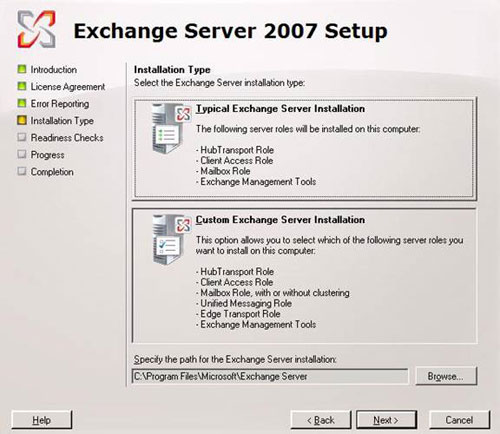
Figure 2: Installation Options (Install Options)
When choosing the Custom type and clicking Next , you are provided with a number of options and can choose one or more of the roles you want to install. You can choose to install Active, Passive Mailbox server clusters or Management Console (see Figure 3).

Figure 3 : Server Roles
Before continuing, you must provide the name of the Exchange Oranization organization and be asked if any computer is using Outlook 2003 or earlier Outlook versions (see Figure 4). If you select Yes , the public Folders public folder will be created. If you select No , nothing happens.
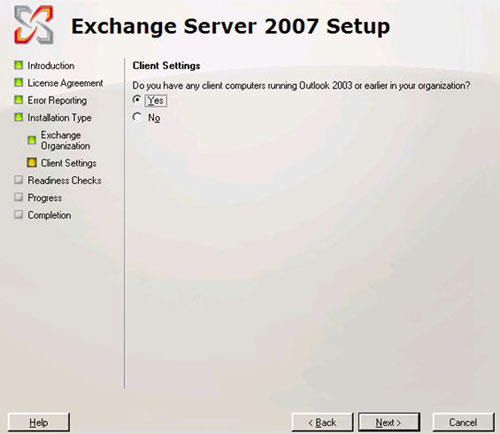
Figure 4 : Outlook versions
You need to be cautious when choosing roles to install. If you are running in a multi-site AD environment, you need to install a Hub Transport and Mailbox server in each AD Site. Client Access Server is also needed in each site with a Mailbox server. Finally, all roles can be installed in the same server (except the Edge Transport) or on each individual server.
Now the installer will run a set of test requests to determine if the domain and server are ready to receive Exchange 2007. Figure 5 illustrates an example of some common errors you will encounter if IIS is omitted or the domain is not at the required functional level. (Note the Install button is dimmed).
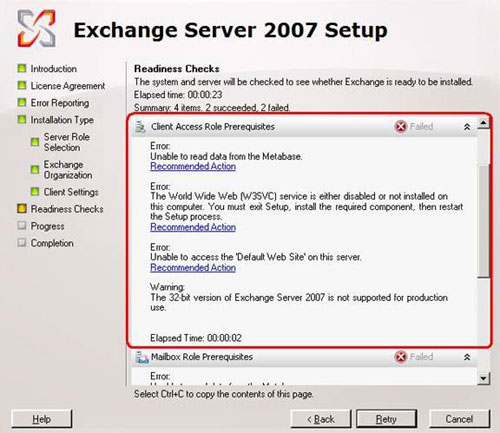
Figure 5 : Error checking availability level
When no errors appear, the Install button appears. You can click on it to start the installation program (see Figure 6).
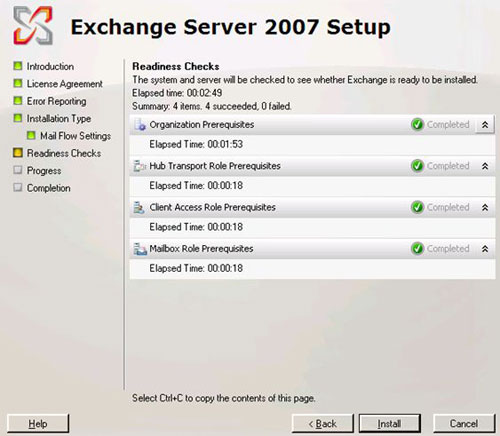
Figure 6 : Check the readiness level successfully
You can see the installation process, how long the installation takes depends on the role installed. Once finished, click the Finish button. The next job is to build the configuration for the Exchange 2007 server (See Figure 7).
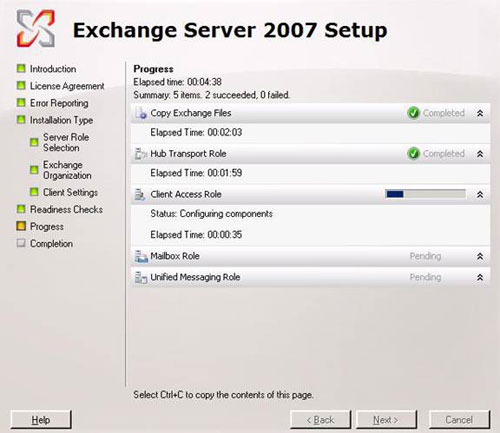
Figure 7 : Installation process
CLI and installation program are not monitored
Exchange 2007 also supports the Command Line Interface (CLI) installation, which can be used to perform unattended installations. There are some required changes depending on the type of Exchange 2007 installation you are working on.
/ roles - describes the server role to be installed. Can be replaced with / r
- ET or E - Gateway Server
- HT or H - Bridgehead Server
- CA or C - Client Access Server
- MB or M - Mailbox Server
- UM or U - Unified Messaging
- MT or T - Admin Tools
- / PrepareAD - used to prepare a "manual" Active Directory schema. This variation is optional because the schema is automatically expanded during the installation process. Can be replaced by / p
- / TargetDir - describes the directory for installing Exchange 2007. Can be replaced by / t
- / SourceDir - describes the location of the installation file
- / DomainController - allows you to specify which DC to use. Can be replaced with / dc
- / AnswerFile : filename
- / mode - determine whether the installation model is the default installation or recovery installation. Required if you want to use transform / RecoverServer
- Install - this is the default model, used when no switch / mode command is provided
- Upgrade - is the model used when upgrading the Exchange 2007 installation program
- Uninstall - used when you want to remove Exchange 2007 or its role
- RecoverServer - used when recovering a failed Exchange 2007 server
The basic syntax of CLI or unattended installation program is as follows:
Setup.exe / console / roles: / mode: [/ targetdir:] [/ prepareAD] [/ RecoverServer] [/?]
To install Exchange 2007 with Bridgehead, Client Access and Mailbox server roles, use the following command:
Setup.exe / roles: ET, MB, CA or
Setup.exe / r: E, M, CWhen you want to install the Gateway server, put the " Program files " program files into a folder in drive D named E2007 and read, write it from DC1, you need to use the following transformation command in Setup.exe:
Setup.exe / r: E / targetdir: D: E2007 /dc:dc1.thelazyadmin.lab
This final example explains which command you will use to install the new Exchange 2007 server during the "disaster" recovery process.
Setup.exe / mode: recoverserver
When this command is executed, the installation program determines whether .NET 2.0 Framework, MMC 3.0 and Microsoft Shell are installed. If any other checked software fails, the installation program will stop and give an error message.
Check the settings
After the installation process is complete, you should check that everything has been successfully completed. There are several ways you can do it. First open MSH and run the following command, which will give a list of installed roles (see Figure 8).
Get-ExchangeServer
Figure 8: MSH Get-ExchangeServerNext, consider the Application Log application log information in Event Viewer with events with ID numbers of 1003 and 1004. These two events provide information to see if the installation was successful. Finally interested in some log files created.
• % SystemDrive% ExchangeExchangeSetupLogsSetup.log : This file tells you whether the pre-installation request checks are okay and which roles are installed.
• % SystemDrive% ExchangeSetupLogsExchangeServerMSI.log : This file tells you whether the file decompression process is responsible for any errors.
• % SystemDrive% ExchangeSetupLogsExchange Server Setup Progress.log : This file tells you which system changes were made during the installation process.
• % SystemDrive% Program FilesMicrosoftExchange Server LoggingSetupLogssetup.log : This file keeps track of the activities during installation. You should see this file if the installation program fails.
Conclude
There are many configuration options and settings in Exchange 2007 for you to choose from. The command line interface provides powerful and scriptable options for deploying Exchange 2007 servers with the smallest administrative interaction. Both installation types perform some pre-installation system requirements checks to ensure that Exchange 2007 installation is started correctly from the original. -
You should read it
- Forward from Exchange 2000/2003 to Exchange Server 2007 (part 2)
- Backup for Exchange Server with DPM 2007 (Part 1)
- Backup for Exchange Server with DPM 2007 - Part 3: Backup process
- Checking Exchange Server 2007 with MOM 2005 (Part 1)
- Remote Exchange 2003 administration
- Checking Exchange Server 2007 with MOM 2005 (Part 3)
- Backup for Exchange Server with DPM 2007 - Part 2: Configure DPM 2007
- Convert from Exchange 2000/2003 to Explorer Server 2007 (Part 3)
May be interested
- Transfer Exchange 2003 to Exchange 2007 (Part 2)
 in this article, we will continue the process to build the exchange 2007 system starting with the installation of the hub transport and client access server.
in this article, we will continue the process to build the exchange 2007 system starting with the installation of the hub transport and client access server. - Instructions for installing Exchange Server 2010 - Part 1: Installation
 it has been a long time since we last introduced you to a microsoft product. we note that the 2010 exchange has not been mentioned. so why not try and check on its new features?
it has been a long time since we last introduced you to a microsoft product. we note that the 2010 exchange has not been mentioned. so why not try and check on its new features? - Installing, configuring, and testing Exchange 2007 CCR on Mailbox Server (Part 3)
 in the second part of this series, we installed the necessary components, enabled and configured the file share witness for majority node set (mns) quorum as well as the transport dumpster on the hub transport server. in this section we will install windows server 2007 for both nodes in the windows 2003 cluster. after that will finish lesson v
in the second part of this series, we installed the necessary components, enabled and configured the file share witness for majority node set (mns) quorum as well as the transport dumpster on the hub transport server. in this section we will install windows server 2007 for both nodes in the windows 2003 cluster. after that will finish lesson v - Switch from Exchange 2000/2003 to Exchange Server 2007 (part 1)
 how is the conversion from exchange server 2000 or exchange server 2003 to exchange server 2007 done? you will have to move data from every available exchange server in the exchange organization to the new exchange 2007 servers after having them shut down.
how is the conversion from exchange server 2000 or exchange server 2003 to exchange server 2007 done? you will have to move data from every available exchange server in the exchange organization to the new exchange 2007 servers after having them shut down. - Managing Resource Mailboxes in Exchange Server 2007 (Part 2)
 in the previous part of this series, we learned how to create a resource mailbox and how to enable it so that a user can access it through the add-mailboxpermission cmdlet. at that time, we still couldn't do this through the exchange management console, but today with exchange server 2007 service pack 1
in the previous part of this series, we learned how to create a resource mailbox and how to enable it so that a user can access it through the add-mailboxpermission cmdlet. at that time, we still couldn't do this through the exchange management console, but today with exchange server 2007 service pack 1 - Transfer Exchange 2003 to Exchange 2007 (Part 3)
 in the previous two sections, we installed the first exchange 2007 servers, combining hub transport and client access servers in an exchange 2003 environment.
in the previous two sections, we installed the first exchange 2007 servers, combining hub transport and client access servers in an exchange 2003 environment. - Transfer from Linux Mail Server to Exchange Server 2007 (Part 1)
 in exchange server 2003, we can use the exchange migration wizard to switch from an imap4 running environment to active directory and exchange server 2003. in this article, however, i don't want to talk about exchange server 2003 but instead. gi
in exchange server 2003, we can use the exchange migration wizard to switch from an imap4 running environment to active directory and exchange server 2003. in this article, however, i don't want to talk about exchange server 2003 but instead. gi - Discover EMC in Exchange Server 2010 (Part 2)
 in the previous article, we learned some new features in exchange server 2010, including: high availability, archiving, federation and sharing.
in the previous article, we learned some new features in exchange server 2010, including: high availability, archiving, federation and sharing. - Exchange's Pickup folder
 if you have browsed the directory structure created after installing exchange 2007, you can find a folder called pickup that appears in some folders under the original exchange. this folder is also available in some previous versions of exchange and so you probably already know a bit about it.
if you have browsed the directory structure created after installing exchange 2007, you can find a folder called pickup that appears in some folders under the original exchange. this folder is also available in some previous versions of exchange and so you probably already know a bit about it. - Installing, configuring and testing Exchange 2007 CCR on Mailbox Server (Part 1)
 exchange server 2007 introduces a number of new features, one of which is the cluster continuous replication (ccr) feature. this feature requires the log file transfer of the new exchange server 2007 and replay features, plus a combination of them.
exchange server 2007 introduces a number of new features, one of which is the cluster continuous replication (ccr) feature. this feature requires the log file transfer of the new exchange server 2007 and replay features, plus a combination of them.











 Secure Outlook Web Access using SSL
Secure Outlook Web Access using SSL Use Admodify.net for Exchange 2003 administration and recovery
Use Admodify.net for Exchange 2003 administration and recovery Forward from Exchange 2000/2003 to Exchange Server 2007 (part 2)
Forward from Exchange 2000/2003 to Exchange Server 2007 (part 2) Convert from Exchange 2000/2003 to Explorer Server 2007 (Part 3)
Convert from Exchange 2000/2003 to Explorer Server 2007 (Part 3) Use the RecoverServer switch to restore Exchange 2007
Use the RecoverServer switch to restore Exchange 2007